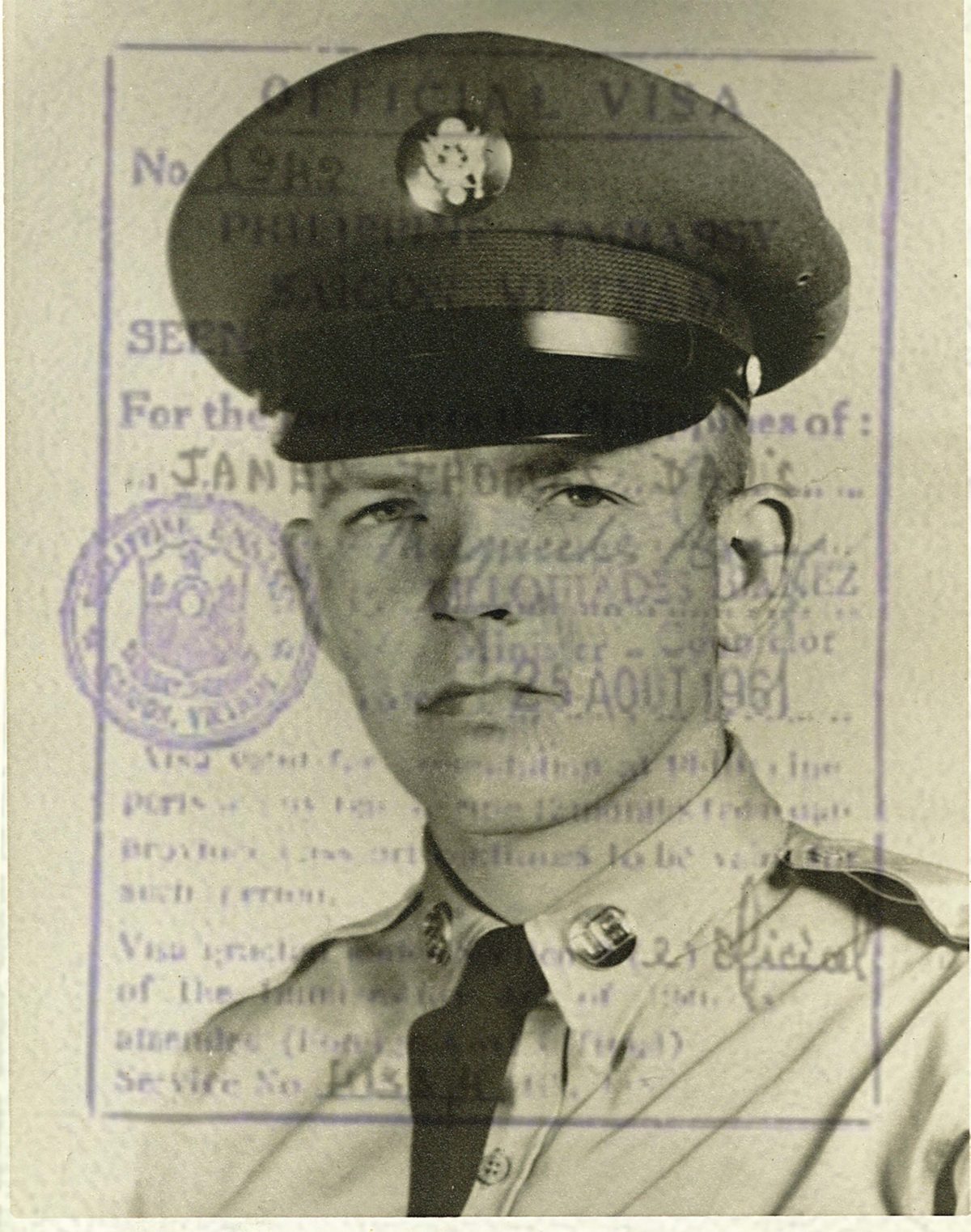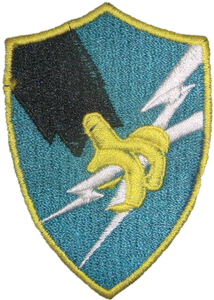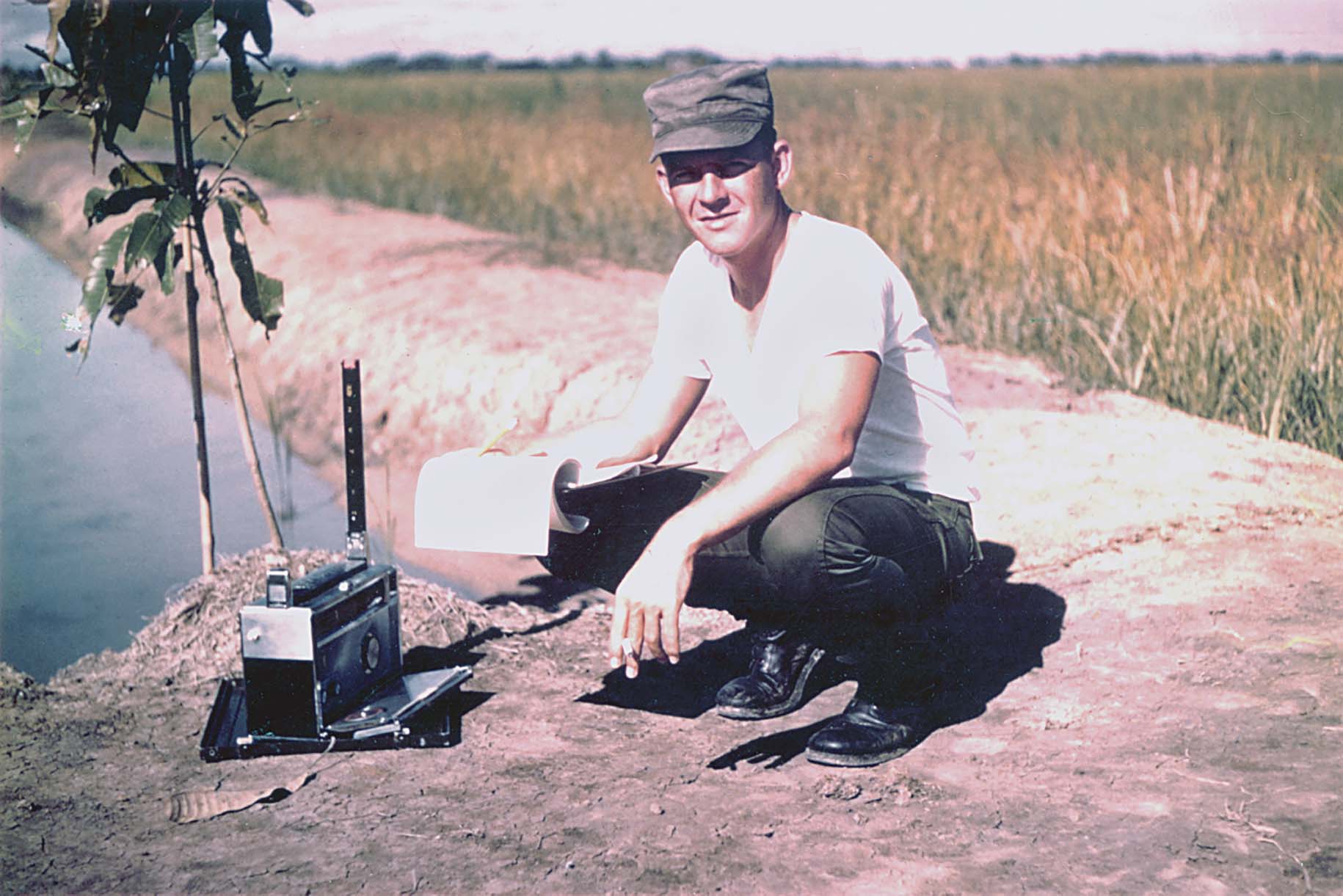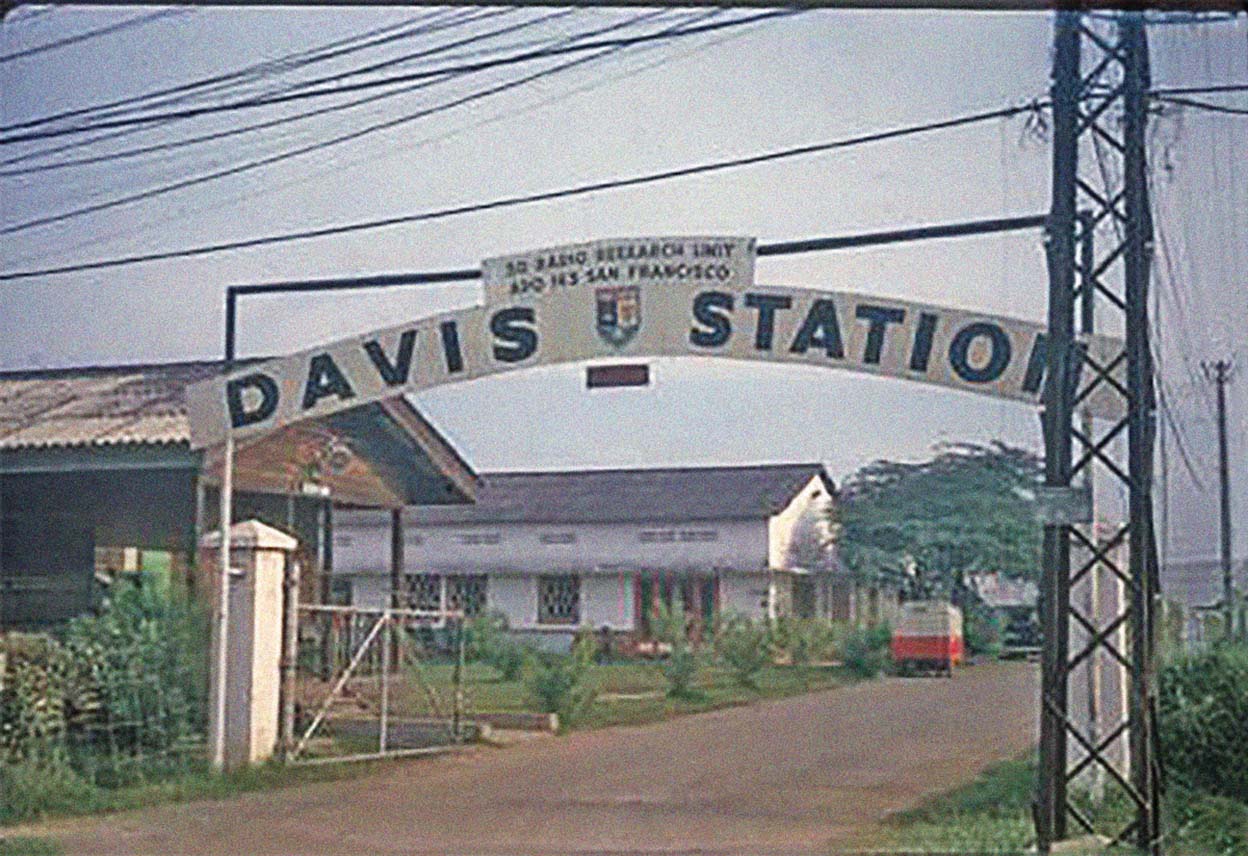
On the morning of Dec. 22, 1961, three trucks carrying members of the 3rd Radio Research Unit, their intelligence counterparts in the Army of the Republic of Vietnam and an ARVN security detail rolled out the gate of their compound at Tan Son Nhut Air Base on the outskirts of Saigon. This compound was a high-security area surrounded by barbed wire fences. Only people with a legitimate reason for being there and “a need to know” were admitted. The small convoy was embarking on a mission west of Saigon.
When it ended, all but one member in the third truck would be dead. Among the casualties was Spc. 4 James T. “Tom” Davis, age 25, the first American to die in a ground combat action in Vietnam.
TOP SECRET UNIT
Davis grew up in the small town of Livingston, Tennessee, about 100 miles northeast of Nashville. It was a rural area with lots of mountains, streams and woods. According to his family, Davis was an “outdoor person” who spent most of his time fishing, hunting, trapping and roaming the woods. After high school, Davis attended Tennessee Polytechnic Institute but left to enlist in the Army.
When he completed basic training Davis was sent to Fort Devens, Massachusetts, for Morse intercept training at the Army Security Agency. Afterward he was selected for radio direction finding school, where the Army sent its most promising ASA students to learn how to locate enemy communications signals.
In early 1961, under increasing pressure from communist guerrillas, the South Vietnamese government requested additional assistance, including military support from the United States. On Saigon’s wish list were equipment, personnel and training to support an intelligence program to monitor the communications of the North Vietnamese-backed Viet Cong.
In response to this request, the U.S. Army sent radio receivers as well as AN/PRD-1 direction finders. Shortly thereafter, the ASA formed the 3rd Radio Research Unit. The term “radio research” was chosen to disguise the unit’s secret connection to the ASA. The troops needed for this deployment were assembled and equipped at Fort Devens within three days after President John F. Kennedy signed an executive order establishing the unit on April 27,1961.

The newly formed ASA radio research unit developed plans for two operations. Operation Whitebirch was a 77-man unit established to target Viet Cong communication transmitters. The second operation, Sabertooth, would field a 15-man team to train ARVN communications intelligence operators. The highly skilled, highly trained and highly secret 92-man contigent of the 3rd Radio Research Unit arrived at Tan Son Nhut on May 13, 1961.
It was the first entire Army unit to deploy to Vietnam, although the men who got off the plane wore civilian clothes, a reflection of their secretive assignment. Previously, members of the military arrived as individuals and were placed in units after they were in-country. U.S. personnel in Vietnam in May 1961 were assigned to Military Assistance Advisory Group-Vietnam, formed in November 1955. The U.S. had approximately 3,000 military personnel in Vietnam at the time.
SEARCHING FOR A COMMUNIST TRANSMITTER
For several months during the fall of 1961 intelligence reports indicated a significant increase in enemy troop strength and activity around the town of Duc Hoa in Hau Nghia province, some 15 miles west of Saigon. That area had a history of communist insurgency dating back to French colonial days. By late fall Viet Cong activity had increased significantly. The ARVN command, their American MAAG-V counterparts and U.S. and South Vietnamese intel specialists suspected the Viet Cong had established a battalion headquarters and communication center in the vast expanses southeast of Duc Hoa.
By December, teams from the 3rd Radio Research Unit had begun to make forays into that area searching for a suspected communist transmitter. The most recent mission took place on Dec. 18 when the unit detected very strong radio signals from the suspected transmitter. The radio research troops were confident that they had acquired an accurate “fix” on its location.
Spc. 4 William Bergman, a member of the radio research unit, said in email correspondence with this article’s author, “The sad thing about the ambush is, that four days earlier on Dec. 18, we had obtained a fix on the enemy’s transmitter. On the mission of the 18th, I was in the lead unit, and we had set up just off the edge of the road. When their transmitter came up, it nearly blew out my eardrums.” The transmitter appeared to be sited in vast pineapple fields south of the villages of Cau Xang and Chau Hiep.
Even though the Americans had obtained what they considered accurate and actionable intelligence, ARVN commanders in Saigon ordered yet another mission to reconfirm the transmitter’s location, now designated as Target 627-C. They refused to commit their troops on an operation without another confirmation. Thus on Dec. 22, members of the 3rd Radio Research Unit and their ARVN counterparts set out yet again to confirm the transmitter’s location.
The troops on the mission were divided into three separate radio direction finding teams. Each team consisted of one American, several ARVN radio technicians and a small detachment of ARVN security personnel. While the teams normally operated out of three-quarter-ton trucks, essentially pickup trucks, this time they requested three bigger 2½-ton cargo trucks to carry a larger security group, a response to an ambush earlier that month near Duc Hoa. Only two 2½-ton trucks arrived the morning of Dec. 22.
One team had to use a three-quarter-ton truck—and thus fewer security personnel. That was Davis’ team.
AN ISOLATED LOCATION
Team 1 was headed by Bergman, a radio direction technician who took the front passenger seat in the cab of a 2½-ton truck. In the second large truck was Pvt. Richard Simpson and his team. The three-quarter-ton truck brought up the rear, with Davis in the front passenger seat.
The teams headed to the Cau Xang-Chau Hiep area, about 9 miles west of Saigon in the vicinity of Duc Hoa. The road, Highway 10, was narrow, rough and dusty, but it was the highest elevation for miles in all directions and provided an excellent view. As the three-truck convoy moved west the terrain changed from dry, lightly populated uplands to marshy emptiness as far as the eye could see, spreading south into the Mekong Delta and westward to the Cambodian border. The countryside consisted mostly of rice paddies and reeds, interlaced with hundreds of canals and a few scattered patches of woods. The rest was the old French Thieng Quang pineapple plantation. The three teams were nearing their destination by midmorning with the villages of Cau Xang and Chau Hiep just ahead.

The teams on the Dec. 22 mission had figured out the enemy radio transmission schedules on previous missions and planned to use those schedules to confirm the location of the transmitter. Radio direction finding teams preferred to take bearings from several different directions, but this area’s extensive wetlands and the lack of roads made that impossible. The radio technicians would have to make calculations from only three positions along the same road. The teams established a 3-mile baseline along Highway 10 near Cau Xang and waited for the Viet Cong transmissions to begin.
In the typical process, once the transmissions begin an operator shoots a bearing using a radio direction finder, a receiver that picks up the transmitter’s signal and determines the direction it’s coming from. The operator draws a line on a map from his location outward in the direction of the signal. This process is conducted simultaneously at each of the other two teams’ locations. Once completed, notes are compared. The point at which the three lines intersect should be the location of the enemy transmitter.
A FATAL DECISION
Two teams believed they were at good signal detection points, but “Tom was not satisfied with the quality of his signal and had made a request by radio to Control Net for permission to move to a better location,” Bergman recalled. Davis needed to move quickly, however, because the next transmission was scheduled to take place shortly.
The similar operations conducted by radio research teams in recent weeks had not gone unnoticed by communist forces in the area. The three Dec. 22 teams needed to complete their mission and get out as fast as possible.
The lead truck with Bergman was parked on the north shoulder of the road at an old French fort a hundred feet or so west of the Cau Xang Bridge when Davis’ request for one more transect came over the radio about 11:30 a.m.
Shortly after Davis got the go-ahead, his truck came over the bridge and drove past Bergman’s to get a better location for that last bearing. Bergman watched as Davis proceeded west on the road. About two minutes later, “I saw a black plume rise vertically from the roadbed,” Bergman said. “Then I heard and felt the explosion and the sound of automatic weapons…then silence.”
Bergman’s team raced to help Davis and the 10 ARVN troops in his team. By the time Bergman’s men arrived, the engagement was over, and the enemy had vanished. The sole survivor of the ambush was Davis’ ARVN driver.
WHAT REALLY HAPPENED?
According to the driver’s account, recalled by Bergman, the Viet Cong had set off a remotely detonated mine (later determined to be a Czechoslovakian-made artillery shell) buried in the road. The mine was triggered a little late and exploded just after the truck passed over it. Even so, the explosion disabled the vehicle, which continued down the road about 30 yards, then rolled into a ditch. Intense small-arms fire from Viet Cong ambushers hiding alongside the road ripped into the vehicle. All nine ARVN soldiers in the truck’s cargo area died from the explosion or the subsequent VC gunfire.
Davis survived the explosion unscathed. He grabbed his M1 carbine and scrambled off the truck, taking with him a satchel containing secret communication codes and other classified materials. He immediately threw the satchel into the water to keep it out of enemy hands and returned to the truck as small arms-fire cracked all around him. He pulled his wounded ARVN driver from the vehicle, while still under intense fire, and shoved the man into a culvert to hide him from the Viet Cong.
Davis then ran west on the gravel road, turning and firing his carbine to draw enemy fire toward himself and away from other team members. He ran a short distance, turned and fired on the ambushers again. Davis was hit and fell, some 50 feet or so from the vehicle. The Viet Cong, no longer receiving any return fire, rushed to the wounded Davis. They shot the American in the head, killing him.
According to the driver’s testimony, the attackers searched Davis for anything of value including his watch. However, Davis, an experienced radio direction finder, kept his watch in a breast pocket so it would not interfere with the direction-finding process. The Viet Cong didn’t have time to search his body any further. Bergman’s team and an ARVN relief force were rapidly approaching from the east. The attackers quickly fled.
THE AFTERMATH
A radio call was made to ASA headquarters at Tan Son Nhut. Within an hour an officer from the 3rd Radio Research Unit and a member of the ARVN general staff were dispatched to the ambush scene. Arriving by helicopter, they picked up the wounded driver and retrieved the bodies of Davis and the nine dead ARVN soldiers. All were returned to Saigon on an aircraft that was part of the 57th Transportation Company (Light Helicopter), which had arrived in Vietnam less than two weeks earlier.
On Dec. 11, 1961, the carrier USS Core docked in downtown Saigon with 32 Army Piasecki CH-21 Shawnee helicopters and 400 men belonging to the 57th Transportation Company (Light Helicopter) from Fort Lewis, Washington, and the 8th Transportation Company (Light Helicopter) from Fort Bragg, North Carolina. This event was the first major symbol of American combat power in Vietnam and the beginning of a new era of airmobility in the U.S. Army.
The morning following the Dec. 22 ambush, 30 CH-21s of the 8th and 57th Transportation companies were loaded with several hundred troops from ARVN’s elite Airborne Brigade. Using fresh intelligence from Davis’ outfit, the 3rd Radio Research Unit, they headed west to attack the Viet Cong at the Thieng Quang pineapple plantation in Operation Chopper, the first helicopter assault of the Vietnam War.
Already in place along a canal south of the target was an ARVN blocking force to prevent a VC escape. The lead helicopter in the formation was piloted by Chief Warrant Officer Bennie Potts of the 57th Transportation His co-pilot was Capt. Emmett Knight, the operations officer of the 57th and the man responsible for planning the aviation component of the mission. “We were looking for a large sugar mill near the distinctive ‘Y’ intersection with the An Ha and the Kinh Xang canals,” Knight, who retired as a colonel, said in an interview with this article’s author. “From there, we were to bank to the left and begin our descent to the LZ about 5 clicks [kilometers/3 miles] to the south. We flew in at 500 feet and initiated a 500 foot per minute decent.”
The location of a radio transmitter suspected to be part of the Viet Cong command center for the Saigon region had been verified by Davis and the two other radio direction finding teams the previous day and was one of the assault’s targets.

As the choppers headed south along the Kinh Xang canal they flew over portions of the pineapple plantation and passed a huge statue of Buddha sitting only a half-mile south of Cau Xang. Later in the war and for many decades beyond, this would be known as The Lonely Buddha.
The choppers landed about 3 miles south of of Cau Xang. Reports indicated the Viet Cong were completely surprised by the speed with which the ARVN airborne troops surrounded them. The radio transmitter was put out of operation and an unknown number of Viet Cong killed and captured.
Operation Chopper’s success was directly attributed to the Americans of the 3rd Radio Research Unit and their Vietnamese counterparts, who diligently searched for and located the transmitter—for which Davis and nine ARVN soldiers paid the ultimate price.
Davis was buried in his hometown at Livingston’s Good Hope Cemetery on Jan. 3, 1962. On Jan. 10, less than three weeks after his death, the Army Security Agency officially named the 3rd Radio Research Unit’s Tan Son Nhut compound “Davis Station.” V
Mark D. Raab served in Vietnam February 1970-March 1972 as a specialist 4 in the 277th Field Artillery Detachment, 23rd Artillery Group, II Field Force. A student of Southeast Asia and the Vietnam War, he has returned to Vietnam four times beginning in January 1989. He retired as a superintendent of Natural Resources in Howard County, Maryland, in 2015. He lives in Reisterstown, Maryland.
2 replies on “HE WAS THE FIRST U.S. SOLDIER KILLED IN GROUND COMBAT IN VIETNAM Spc. 4 James T. Davis lost his life tracking down an enemy signal in Vietnam By MARK D. RAAB”
Just remember… the first causality is always the truth. And none of us did it for the American people’s safety. We did it for the fucking bankers.
I see that you are a fan of “War is a racket” Smedley Butler USMC Ret. Sadly I almost agree with you on this one.